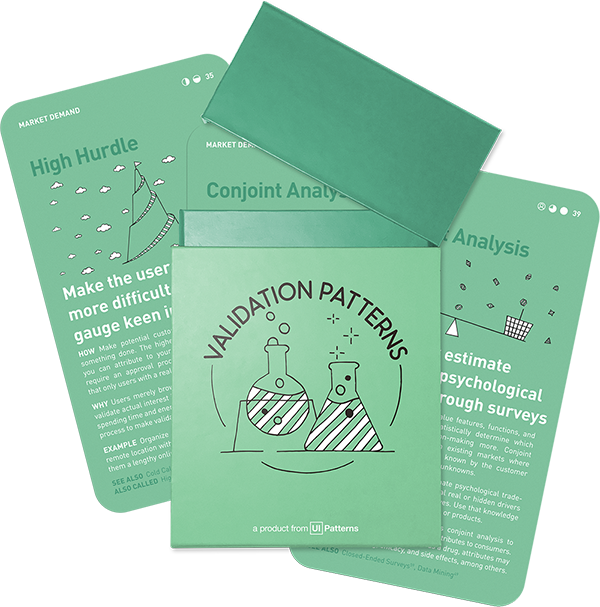Evidence strength
Relevant metrics: Acquisition, Activation, Customer feedback, Cost
Validates: Feasibility, Viability, Desirability
How: Be upfront about the manual work involved in your product or service and deliver it as a highly customized service to select customers instead of faking a working product like you would with a Wizard of Oz experiment.
Why: Running through your process manually reveals other aspects of the customer experience that can prove valuable later on.
This experiment is part of the Validation Patterns printed card deck
A collection of 60 product experiments that will validate your idea in a matter of days, not months. They are regularly used by product builders at companies like Google, Facebook, Dropbox, and Amazon.
Get your deck!Before the experiment
The first thing to do when planning any kind of test or experiment, is to figure out what you want to test. To make critical assumptions explicit, fill out an experiment sheet as you prepare your test. We created a sample sheet for you to get started. Download the Experiment Sheet.
Replacing complicated automations with human power
When contemplating your final idealized product, it is often full of bells and whistles giving users a smooth onboarding, smart recommendations, and triggering user retention with elaborate email automation. Even though this is what we dream to accomplish, you have no proof in the beginning that users actually want all this.
A clever way to test whether your ideal final product is relevant for future customers is to throw out all the niceties and replacing that with raw human power. A concierge MVP.
By simplifying a product by replacing automated compontents with human power, all customers receive a near-perfect treatment with humans delivering the service all around. Skipping building the product will allow you to get immediate feedback early and will put you directly in touch with early customers. This will allow you to understand customer needs deeply, but also whether they actually want what you are offering. You will learn what kind of questions customers might have and what answers move them forward.
At the same time, conducting everything yourself by hand, will provide an appreciation and understanding of what it takes to deliver the final product.
Doing something that doesn’t scale
As you might have guessed, Concierge MVPs rarely scale on the long run. That’s ok. The purpose is to test before you build. Once you have thousands of users, you can start worrying about scaling - if you don’t, then why bother?
By conducting a Concierge test, you can test your product hypothesis without building more than a landing page. As your service is delivered by humand manually, you can interact personally with customers and achieve a deep understanding of what your customers are dealing with.
After the experiment
To make sure you move forward, it is a good idea to systematically record your the insights you learned and what actions or decisions follow. We created a sample Learning Sheet, that will help you capture insights in the process of turning your product ideas successful. Download the Learning Sheet.
Examples
Rent the Runway
Rent the Runway tested its online dress rental business model by providing an in-person service to female college students where they could try a dress on before renting it. This helped validate the hypothesis that women would rent dresses and proved they would pay money for the service as well.
Source: Building a Minimum Viable Product? You’re Probably Doing it Wrong
Get Maid
Get Maid, an app for booking home cleaning, validated their concepts by first product by creating a skinny front-end app that would merely send the founders a text message. When receiving a message, they would check to see who was available and then text the customer that the appointment was confirmed once they found a maid.
Food on the Table
When Food on the Table first started, CEO Manuel Rosse didn’t have a website, but sold his service for $10 a month in person to shoppers. As he got his first customers, he generated the recipes and grocery lists his service promised in person, while accompanying them around the store.
Source: Learn about Lean Startup
Related plays
- Concierge vs. Wizard of Oz Test - what's the difference by Tristan Kromer
- Validating Product Ideas Through Lean User Research by Tomer Sharon
- Building a Minimum Viable Product? You’re Probably Doing it Wrong by N. Taylor Thompson
- Learn about Lean Startup by Patrick O'Malley
- The Real Startup book - Concierge by Tristan Kromer, et. al.

